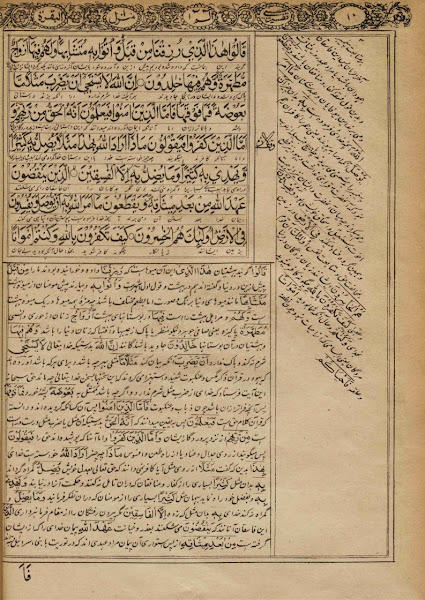NoStandard
Thursday, 17 April 2025
Delhi 1867 Tafsīr-i Ḥusaini
Tafsīr-i Ḥusainī by Ḥusain Waʿiẓ Kāšifī
The Koran, accompanied by the Hindustani interlineary translation by رفيع الدين دهلوي Rafīʻ ud-dīn Dihlavī, 1749-1818, with the Persian commentary of Ḥusayn Vāʿiz Kāshifī
كاشفي، حسين واعظ
d. 1505 or 1504 on the margin.
for comparison
Bombay 1880 Tafsīr-i Ḥusaini
Tafsīr-i Ḥusainī by Ḥusain Waʿiẓ Kāšifī
Four pages are missing in the digital version (British Library, Gale)
Tuesday, 8 April 2025
Ṣaddām Ḥusain prints
During the reign of Ṣaddām Ḥusain the (joined Sunni-Šiʿi) Diwān of Auqāf
reissued two Ottoman manuscripts:
one written by Muḥammad ʾAmīn Rušdī (MAR) +
one by Ḥasan Riḍā (ḤR) both non-berKenar.
A close look at the fatiḥa shows that they are identical.
Above on the left from a Turkish facsimile edition of Ḥasan Riḍa,
in the Middle the ʿIrāqī "ḤR", on the right the ʿIrāqī "MAR",
next page 3 from the two ʿIrāqī prints:
As the fatiḥa is identical, it is likely that it was written in both prints by the "improver" Hāšim Muḥammad al-Baġdādī, who fixed everything that was deamed "wrong" by al-Wāʾiẓ.
Two remarks:
ʿIrāq was not affected by the "revolution" of 1924.
While MAR differentites between /fī qulūbihim/ and /fĭ'l arḍi/, ḤR gets it all wrong
‒ I say: "wrong" because from Istanbul to Batavia the differentiation is the rule.
Last a comparison between the two Ottoman scribes and ʿUṯmān Ṭaha:
both place vowel signs often to the left of their base letter, the sukūn of the final mīm even before the kasra of the letter before!
(and ḤR's hā' has both a ǧazm and a kasra ‒ ???)
UT, on the other hand, places all signs at the proper place ‒ and the final mīm gets not sukūn, that is implied in the šadda on the following mīm.
Below from two early Moroccan prints, to show one of my points:KFE was a switch from Asian to African.
‒
Subscribe to:
Posts (Atom)
-
There are two editions of the King Fuʾād Edition with different qurʾānic text. There are some differences in the pages after the qurʾānic t...
-
there is no standard copy of the qurʾān. There are 14 readings (seven recognized by all, three more, and four (or five) of contested status...
-
Most Germans find it strange that Americans are obsessed with race. Yes, some skin is darker, some hair frizzy, but after a beach holiday, a...





















































